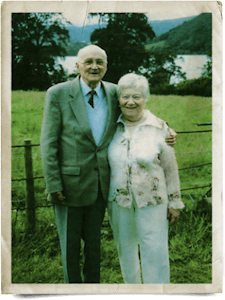Val Ginsburg
Val Ginsburg was imprisoned in the Kaunas ghetto in Lithuania before being sent to Dachau concentration camp. After liberation he met Ibi, they married, and built a new life together.



Waldemar (Val) Ginsburg was born in 1922 and grew up in a secular, free-thinking Jewish family in Kaunas, Lithuania. As a boy, he dreamt of becoming a pilot and spent his time building model aeroplanes. He attended a German primary school but had to transfer to a Lithuanian school in the 1930s. He studied architecture at Kaunas University, but again his education was interrupted as war approached.
Val described Lithuania as a small country ‘trapped on a political fault line’ between two superpowers: fascist Nazi Germany to the West and Communist Soviet Russia to the East.
In the summer of 1940, the Soviet Union occupied Lithuania. The Ginsburgs had their property confiscated and were put on a list for deportation to the East. But they avoided deportation because of the German invasion of Lithuania on 22 June 1941. Val’s family then had to make a difficult choice: flee East into Russia, or remain in Lithuania and try to survive under the Nazis. After a morning of debate, they all chose to stay, hoping their chance of survival was better under the Germans.
“So we preferred the Nazis to the communists. The outcome was that except for myself, all 14 members who gathered that day perished.”
The Jewish population in Lithuania was immediately persecuted. New laws prohibited Jewish people from walking on the pavement, using public transport, owning a telephone or radio, and owning pets. Their access to food was restricted so they were constantly hungry. Arrests and executions were common. Val found this particularly terrifying, as they frequently occurred without warning.







On 15 August 1941, the Jewish population of Kaunas was forced into a ghetto. There was little food in the ghetto and many people died of starvation. Val and his family survived as he was sent outside the ghetto to work as a forced labourer, which enabled him to scrounge or steal potato peelings, which his mother cooked.
Val witnessed two major massacres which had a lifelong impact on him. On 29 October 1941, almost 10,000 people were taken away as part of the ‘Great Action’. They were shot by the Nazis and their Lithuanian collaborators at the Ninth Fort, including seven members of Val’s family. Val said that this was when he and his surviving family lost their faith in humanity.
“We realised that the atrocities were not committed by misfits, or by sadists, or by psychopaths. They were committed by ordinary decent people like you and me.”
He also witnessed the ‘Children’s Action’ (Kinderaktion) which took place from 27-28 March 1944. During the day, whilst many adults were working outside the Kaunas ghetto, the Nazis forcibly took away the children, elderly, sick, and disabled and then murdered them. Val said that this massacre was one of his most stressful memories and his worst experience in the ghetto.


“It’s one of my most stressful memories and I get nightmares and I wonder, when I wake up, I wonder that if God is a master of the universe, why is it that he allowed the ghetto children to be massacred.”
By 1944, the German army was in retreat. The 12,000 remaining Jews were forced onto overcrowded cattle wagons and taken to concentration camps in Germany. During the three-day journey, Val was separated from his mother and never saw her again. He arrived in Dachau concentration camp near Munich and was soon stripped of his identity. He was given a prisoner uniform and an SS guard tore up the precious photograph of his mother, which was his last remaining possession.
Val was sent to Kaufering, a subcamp of Dachau, where the conditions were worse than anything he had experienced in the ghetto. All inmates were forced to perform heavy labour on starvation rations. Most of the remaining Kaunas Jews died of starvation.
Val was liberated on 1May 1945 by the American army. He was the only member of his immediate family to survive. Val’s first emotion was euphoria for finally being free, however this soon turned into a deep depression when he realised that his whole family had been murdered.
He was hospitalised for six months at St Ottilien after liberation. As he was finally beginning to heal, he met Ibi, his future wife, who was working in the hospital administration after being liberated herself. For Val, meeting Ibi was ‘therapeutic’. They quickly decided to marry and create a new life for themselves.
Val’s cousin Margaret also survived the Holocaust and was living in West Yorkshire with her husband, Joseph. Val and lbi decided to join them and moved to England in October 1948, bought their first home in Brighouse, and became British citizens in 1955. They enjoyed working in West Yorkshire’s textile industry and raised their two daughters. They remained a devoted couple for over 60 years.
For many years, Ibi and Val never talked about their experiences, not even to their family. In the 1980s, they decided that they owed it to the victims of the Nazi persecution and the Holocaust to tell their stories. They visited many schools to help inspire tolerance among young people and to raise awareness about the privilege of living in a stable democracy. In 2005, the couple were presented to the Queen on the 60th anniversary of the liberation of Auschwitz.
Val sadly died in June 2011 and is greatly missed.
“We lost everything. But we built everything up again from scratch.”






Can you help us?
Without the work of charities like ours, stories like Val Ginsburg's will be lost and forgotten. Please donate generously to ensure that Val's story can a force for good in the modern world.
- £
